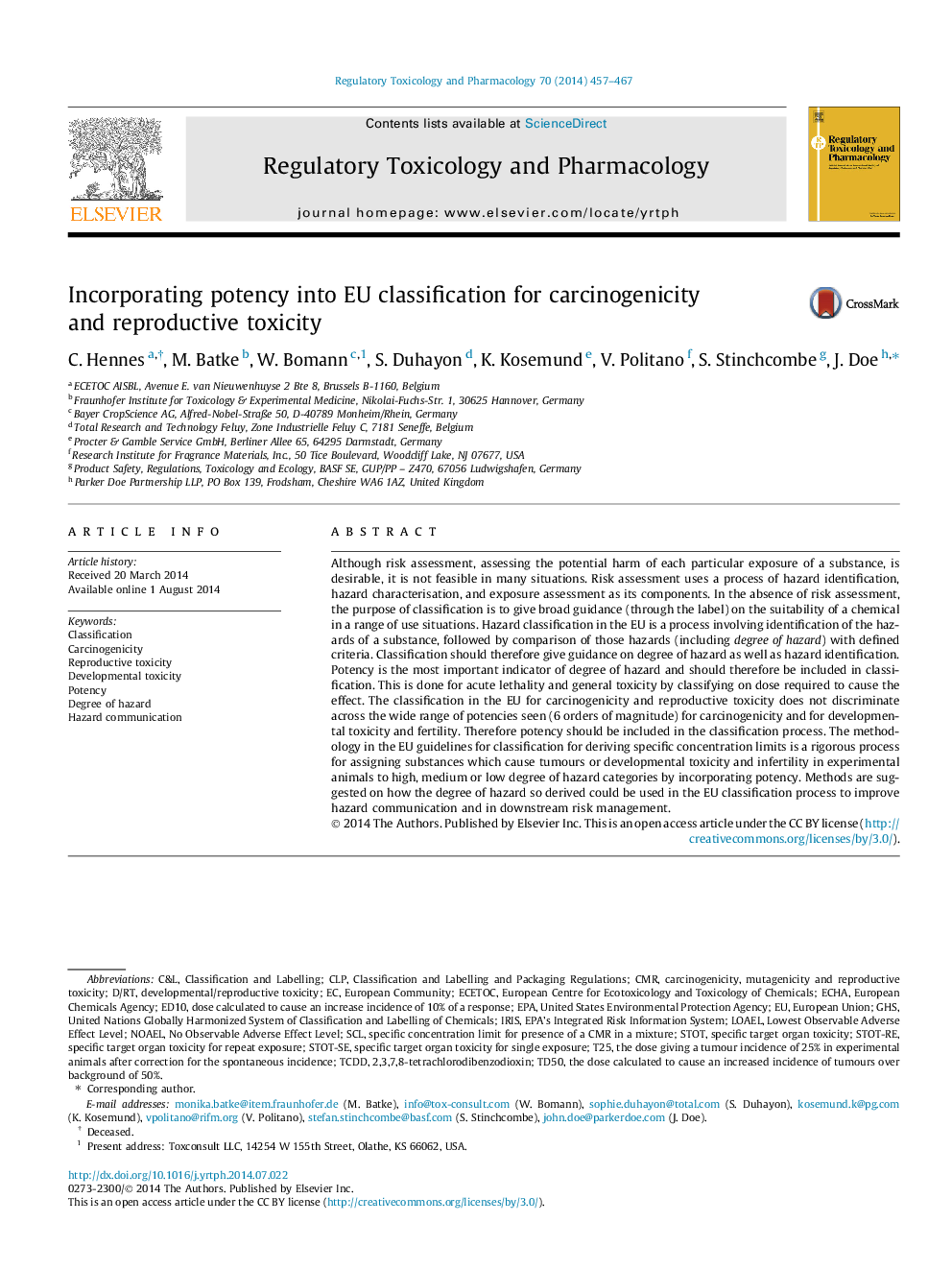| کد مقاله | کد نشریه | سال انتشار | مقاله انگلیسی | نسخه تمام متن |
|---|---|---|---|---|
| 5856781 | 1131983 | 2014 | 11 صفحه PDF | دانلود رایگان |
عنوان انگلیسی مقاله ISI
Incorporating potency into EU classification for carcinogenicity and reproductive toxicity
ترجمه فارسی عنوان
شامل توانایی در طبقه بندی اتحادیه اروپا برای سرطان زایی و سمیت تولید مثل
دانلود مقاله + سفارش ترجمه
دانلود مقاله ISI انگلیسی
رایگان برای ایرانیان
کلمات کلیدی
LOAELTD50ED10lowest observable adverse effect levelGHSECETOCECHANOAELEPASCLC&LCMRCLPTCDD2,3,7,8-tetrachlorodibenzodioxin - 2،3،7،8-تترا کلرویدید بنزیدویکسینUnited States Environmental Protection Agency - آژانس حفاظت از محیط زیست ایالات متحدهEuropean Chemicals Agency - آژانس مواد شیمیایی اروپاEuropean Union - اتحادیه اروپاHazard communication - ارتباطات مخاطره آمیزPotency - تواناییEuropean Community - جامعه اروپاییUnited Nations Globally Harmonized System of Classification and Labelling of Chemicals - سازمان ملل متحد سیستم جهانی طبقه بندی و برچسب زدن مواد شیمیاییCarcinogenicity - سرطان زاییDevelopmental toxicity - سمیت توسعهReproductive toxicity - سمیت تولید مثلClassification - طبقه بندیclassification and labelling - طبقه بندی و برچسب گذاریIris - عنبیهEuropean Centre for Ecotoxicology and Toxicology of Chemicals - مرکز اروپایی سم شناسی سم شناسی و سم شناسی مواد شیمیاییno observable adverse effect level - هیچ سطح قابل توجهی از اثرات قابل مشاهده
ترجمه چکیده
اگر چه ارزیابی ریسک، ارزیابی آسیب احتمالی هر نوع قرار گرفتن در معرض یک ماده مطلوب است، اما در بسیاری از موارد امکان پذیر نیست. ارزیابی ریسک با استفاده از فرآیند تشخیص خطر، مشخص کردن خطر و ارزیابی قرار گرفتن در معرض آن به عنوان اجزای آن است. در غیاب ارزیابی ریسک، هدف طبقه بندی این است که هدایت گسترده (از طریق برچسب) را در مورد شایستگی یک ماده شیمیایی در طیف وسیعی از شرایط استفاده ارائه دهد. طبقه بندی خطر در اتحادیه اروپا یک فرآیند است که شامل شناسایی خطرات یک ماده و سپس مقایسه آن خطرات (از جمله درجه خطر) با معیارهای تعریف شده است. بنابراین طبقه بندی باید بر اساس درجه خطر و شناسایی خطر ارایه دهد. پتانسیل مهمترین شاخص میزان خطر است و بنابراین باید در طبقه بندی قرار گیرد. این امر برای کاهش مرگ و میر حاد و سمیت عمومی با طبقه بندی روی دوز مورد نیاز برای ایجاد اثر انجام می شود. طبقه بندی در اتحادیه اروپا برای سرطان زایی و سمیت تولید مثل در طیف گسترده ای از توانایی های دیده می شود (6 مرتبه) برای سرطان زایی و برای سمیت و باروری توسعه. بنابراین قدرت باید در فرایند طبقه بندی گنجانده شود. روش شناسی در دستورالعمل های اتحادیه اروپا برای طبقه بندی برای برآورد محدودیت های غلظت خاص یک فرآیند دقیق برای اختصاص دادن مواد است که باعث می شود تومور یا سمیت رشد و ناباروری در حیوانات آزمایشی به درجه بالا، متوسط یا کم درجه خطر با استفاده از قدرت. روش ها بر این می شود که چگونه درجه خطر به این ترتیب می تواند در فرایند طبقه بندی اتحادیه اروپا برای بهبود ارتباطات خطر و در مدیریت ریسک پایین دست استفاده شود.
موضوعات مرتبط
علوم زیستی و بیوفناوری
علوم محیط زیست
بهداشت، سم شناسی و جهش زایی
چکیده انگلیسی
Although risk assessment, assessing the potential harm of each particular exposure of a substance, is desirable, it is not feasible in many situations. Risk assessment uses a process of hazard identification, hazard characterisation, and exposure assessment as its components. In the absence of risk assessment, the purpose of classification is to give broad guidance (through the label) on the suitability of a chemical in a range of use situations. Hazard classification in the EU is a process involving identification of the hazards of a substance, followed by comparison of those hazards (including degree of hazard) with defined criteria. Classification should therefore give guidance on degree of hazard as well as hazard identification. Potency is the most important indicator of degree of hazard and should therefore be included in classification. This is done for acute lethality and general toxicity by classifying on dose required to cause the effect. The classification in the EU for carcinogenicity and reproductive toxicity does not discriminate across the wide range of potencies seen (6 orders of magnitude) for carcinogenicity and for developmental toxicity and fertility. Therefore potency should be included in the classification process. The methodology in the EU guidelines for classification for deriving specific concentration limits is a rigorous process for assigning substances which cause tumours or developmental toxicity and infertility in experimental animals to high, medium or low degree of hazard categories by incorporating potency. Methods are suggested on how the degree of hazard so derived could be used in the EU classification process to improve hazard communication and in downstream risk management.
ناشر
Database: Elsevier - ScienceDirect (ساینس دایرکت)
Journal: Regulatory Toxicology and Pharmacology - Volume 70, Issue 2, November 2014, Pages 457-467
Journal: Regulatory Toxicology and Pharmacology - Volume 70, Issue 2, November 2014, Pages 457-467
نویسندگان
C. Hennes, M. Batke, W. Bomann, S. Duhayon, K. Kosemund, V. Politano, S. Stinchcombe, J. Doe,
